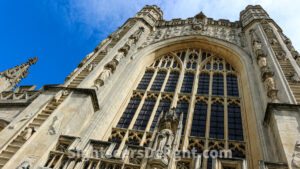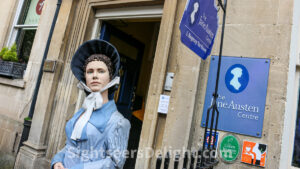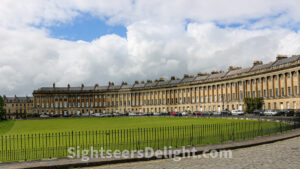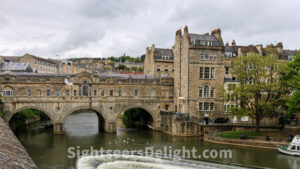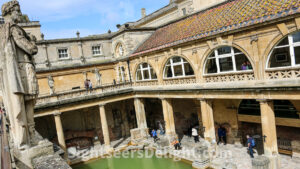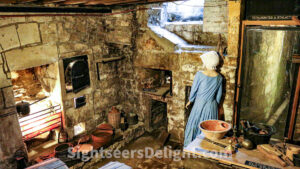The imposing Gothic abbey, a former Benedictine monastery, towers high above the Roman baths and the street below. Osric, King of the Hwicee, founded the parish in 675, and new churches were erected in the 12th century under John of Tours and during the 16th century. One of the building’s most unique features is the ladder of angels located on the west front. According to one account, Bishop of Bath Oliver King designed the ladder based on a dream he had about ascending and descending angels.
Author Jane Austen lived in Bath from 1801 until 1806, and the Jane Austen Centre on Gay Street explores the effect Bath had on Austen’s writings. The museum is certainly a must-see for Austen fans, but it’s also for visitors looking to learn more about historic Bath through the experiences of one of its favorite residents.
A famous semicircle row of Georgian townhouses was built based on designs by architect John Wood the Younger between 1767 and 1774. One of the houses, the No. 1 Royal Crescent, has been preserved as a museum, giving visitors a window into 18th century life. Complete with authentic furniture and artifacts, each room tells a story of daily life 300 years ago. In one of the rooms, the Gentlemen’s Retreat, visitors can learn more about Henry Sandford, the townhouse’s first resident who lived here from 1776 until 1796.
The Pulteney Bridge is a historic bridge in Bath, England, spanning the River Avon. It was constructed in 1774 to link the city with the Pulteney family’s land, which they wanted to develop. Robert Adam designed the bridge, which features a unique Palladian style with shops built on both sides. It has been classified as a Grade I listed building. Within two decades of its completion, the shops were expanded, and the façades were altered. Floods damaged the bridge by the end of the 18th century, but it was rebuilt with a similar design. In the following century, renovations were made to the shops, including cantilevered extensions on the bridge’s north face. Later in the 20th century, preservation efforts were carried out to restore the bridge’s original appearance, making it more attractive as a tourist destination.
The Roman Baths, for which this southwestern England city is named, are some of the most remarkable Roman ruins outside of Rome itself. The area’s natural hot springs were used long before the Romans under Emperor Claudius invaded Britain, starting in 43 AD. Archaeological evidence shows human activity around the springs dating to 8,000 BC, though the area may have been too hot and swampy for a permanent settlement. Today, the Roman ruins stand at the center of this historic city. Much like their counterparts in Rome itself, the bath ruins provide a marvelous insight into both the magnificence of the buildings constructed by the Romans and daily life during Roman times.
Sally Lunn’s is a historical house located in Bath and is known to be the oldest house in the area dating back to 1482. Here, a young Huguenot baker named Solange Luyon, Anglicized as Sally Lunn, invented the first Bath bun in 1680. This regional delicacy, similar to a brioche bun, can be relished with sweet or savory toppings and is popular worldwide. Sally Lunn’s offers a menu based on this famous bun during the day and serves fine English cuisine in the evening. Additionally, visitors can explore the original kitchen used by Sally in the downstairs kitchen museum.

